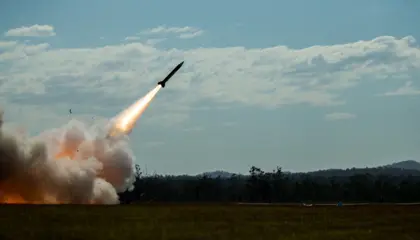Faced with chronic missile shortages and up against probably the most active and most-dense air defense network anywhere, Russian attacks have seen a change in Russian tactics with reliance on more drones and fewer, but more selective, missile strikes.
Russian mission planners seem to have effectively abandoned the earlier strategy of launching nationwide waves of missiles against Ukrainian energy infrastructure and are relying on misdirection and attempting to strike hitting a few selected civilian targets. Ukraine’s air defenses and power grid have, up to now, taken the attacks in their stride, but civilians are still dying.
JOIN US ON TELEGRAM
Follow our coverage of the war on the @Kyivpost_official.
On the night of Mar. 21/22, Armed Forces of Ukraine (AFU) anti-aircraft units shot down two of four Russian cruise missiles aimed at the Black Sea port city of Odesa. In the skies above Kyiv, meanwhile, after a night of air raid warnings and social media swamped with reports of aircraft buzzing around somewhere over the capital, AFU spokesmen announced air defenses had knocked down 16 of 21 Iran-manufactured kamikaze drones launched against the capital.
By previous standards, damage from these two very early-morning attacks, was relatively light. Ukraine’s national power grid hummed on, generating electricity unchecked.
Although Tuesday’s raids were a pale shadow of some of the assaults experienced at the end of 2022 and earlier this year, when on occasions as many as 100 missiles were launched in a few hours resulting in power outages lasting days, by sunrise on Wednesday it was evident that Russia was still terrorizing Ukrainian civilians: four civilians were killed in a suburb of Kyiv and three hospitalized in Odesa.

Ukraine’s Defense Minister Heads to South Korea With Weapons Wish List
In October, Russian President Vladimir Putin had ordered his military to attack Ukraine’s power grid in a bid to bomb the Ukrainian people into submission by forcing them to pass the winter in dark, unheated homes.
Military analyst Oleksiy Getman told KyivPost that Moscow has probably fired more than 2,000 guided weapons at the Ukrainian power grid, other civilian infrastructure and homes since then. His view is that the campaign has definitively failed thanks to a resilient power grid staffed by technicians working 24/7, western deliveries of transformers and anti-aircraft weapons which has allowed a national air defense system to be established that has been able to shoot down four out of every five weapons fired at it.
Getman estimated that, by the beginning of March, Russia’s total missile inventory has fallen so far that it could only call on 500 or so medium-range cruise or ballistic missiles of all types, of which half are highly inaccurate Soviet-era weapons barely able to hit within a square kilometer of an intended target. He said that Ukraine effectively no longer faces the threat of massed attacks by high precision weapons as stores of modern, more-accurate missiles, such as the air-launched semi-hypersonic Kinzhal are so much reduced.
“Russia now has a critically small missile reserve which it cannot just use against Ukraine. The Kremlin needs to retain capacity against China and NATO,” Getman said. “So they are being more careful about what they shoot with and where … they’ve almost stopped using first-line weapons.”
Putin’s bombardment campaign has largely failed, not just because of Ukraine’s formal civil defense network and the help of US/NATO reconnaissance data, but because of the enthusiastic support of ordinary Ukrainians. The speed with which individuals have used social media to report Russian launch locations, post images of missiles passing overhead – allowing flight paths to be tracked and probable target areas to be identified has done its part in protecting the population.
The four cruise missiles fired early on Wednesday morning, called by Russia X-59 and by NATO the AS-13 Kingbolt, were aimed at Odesa by fast-flying attack jets above the Black Sea. This by-passed much of the Ukrainian air warning network and left air defenses around the city little time and distance to engage the incoming weapons, he said.
Another new Russian tactic, as reported by officials, has been to repurpose Cold War-era S-300 anti-aircraft missiles as ground bombardment weapons. The S-300’s guidance system is designed to fly the missile into the general area of a plane but, if fired at a ground target, is unable to hit within a few hundred meters of where it’s aimed. Even so the S-300 is supersonic, hard to intercept and there are thousands of them still in Russian hands. It appears that the Kremlin is willing to sacrifice accuracy for the ability to hurl a 150 kg. warhead up to 150 km at something the size of a city block in the hope of killing and injuring people, they said.
"The S-300 poses an increased threat to front-line territories, such as Zaporizhia and other cities. But in general, this missile terror tactic has already been defeated," AFU spokesman Andriy Yusov said in a Mar. 20 television interview.
Frontline cities like Kramatorsk, Kharkiv, and Kherson have been favorite targets. The most recent S-300 attack was against a commercial district in the industrial city Zaporizhia on Mar. 18.
As Ukraine has become more adept at knocking down cruise missiles, the Kremlin has had to try to identify gaps in the Ukrainian air defense network, sometimes by floating radar-reflecting balloons across the border from Russia and Belarus into Ukrainian air space, and sometimes by flying Iran-manufactured kamikaze drones over major Ukrainian cities for as much as an hour, in an attempt to draw fire.
Ukrainian territorial defense forces have countered this by mounting heavy machine guns on pickup trucks, typically the Toyota Hilux or Ford Ranger, and guiding the gun crews into the drones’ path. The, sometimes, pell-mell engagements typically take place at night in otherwise quiet rural regions to the south of major inland cities like Kyiv, Dnipro and Lviv.
Other Russian goals with the night drone raids, said Trent Telenko, a retired US Defense Department procurement official, is to force Ukrainian forces to expend a half million dollar, NATO-supplied anti-aircraft missile to knock down a cheap Teheran-made drone costing a tenth of that and, more importantly, to leave a gap that could be exploited by more strikes in the future.
“It is getting harder for Ukraine to stop Russian missiles as Ukraine’s stocks of its own S-300 missiles are being exhausted,” Telenko said. “Ukraine no longer tries against S-300 or KH-47, since Western missiles like IRIS-T & NASAM lack the performance to intercept Russian S-300s and Ukraine no longer has enough S-300 missile stocks to try.”
“The Russians have lost the bombardment battle [against the power grid]…but they will keep on shooting,” Yusov said.
A few hours after the drone attacks against Kyiv, and the cruise missile strikes against Odesa, a pair of Russian missiles slammed into an apartment building in the city of Zaporizhia. One exploded, injuring 18 people including two children and hospitalizing 11, the UNIAN news agency reported.
You can also highlight the text and press Ctrl + Enter






